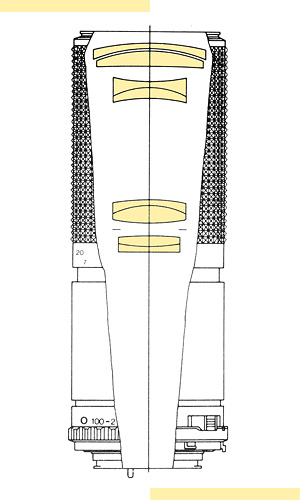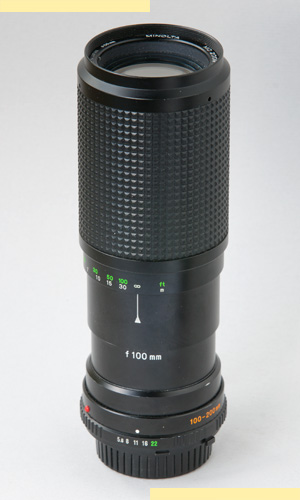The Minolta Zoom 5.6/100-200mm was introduced in 1965. The same optical scheme - probably with some adaptations due to new glass - was used for more than 20 years. Probably the newest samples (MD-II and MD-III) have a better performance than the original Zoom Rokkor from 1965. The optical construction of the Minolta 5.6/100-200mm is unusual, since its focus during zooming is "optically stabilized" (in contrary to the usual "mechanical stabilization"). The lens constst of four achromatic doublets: The first (front) one for focusing, the second for zooming, and the two last ones as the basic lens. No compensating group is needed.
The 5.6/100-200mm originally was a budget zoom (cheaper than the MC 4.5/80-200mm), but towards 1985 the lens had become more expensive than the much more complicated MD 4/70-210mm! Surprisingly, the lens has very good detail resolution, using 16MP APS-C (NEX-5N). Color aberrations (CAs) are nearly inexistent on 24MP Full Frame (Sony A7II) - in this regard the MD 5.6/100-200mm is clearly better than the other Minolta MC/MD zooms of the same range, namely the MC/MD 4.5/80-200mm, the MD 4.5/75-200mm and the MD 4/70-210mm. This certainly was an advantage when removing CAs by software was not an option...
Das Minolta 5.6/100-200 mm ist das Zoom mit der längsten Produktionszeit im Minolta-SR-System. Eingeführt 1965, wurde dieselbe optische Aulegung auch in der MD-III-Variante von 1981 verwendet; allerdings ist anzunehmen, dass Minolta die Rechnung im Verlauf der Jahre an neue Glassorten angepasst und damit die Leistung unter dem Strich verbessert hat. Dieses Zoom ist insofern ungewöhlich, als dass seine Scharfeinstellung "optisch stabilisiert" ist. Dies bedeutet, dass wir je ein vierlinsiges Grundobjektiv und eine vierlinsige Zoom-Gruppe haben; zur Fokussierung werden die beiden vordersten Linsen der Zoom-Gruppe separat bewegt. Eine Kompensator-Gruppe - wie bei fast allen späteren Telezooms - ist nicht nötig!
Das 5.6/100-200 mm blieb - zum Erstaunen vieler - über Jahre hinweg im Lieferprogramm. Es war zuletzt sogar teurer als das MD 4/70-210mm. Eigene Tests an der 16MP APS-C NEX-5N zeigen, dass die Bildschärfe mindestens auf dem Niveau des Minolta MD 4/70-210 mm liegt. Viel wichtiger ist aber (oder war - zu analogen Zeiten, als man CAs nicht einfach aus den Dias herausrechnen konnte ...), dass das Objektiv keine sichtbaren Farbfehler hat. Damit hat es eine Sonderstellung unter den Telezooms im Minolta SR-System, und wohl deswegen blieb es bis zum Schluss als MD-III im Programm.
 |
 |
MINOLTA 100-200mm 1:5.6 (8 Linsen / 5 Glieder)
Fassungen: SR-I (1965), MC-X (1972), MD-I (1977), MD-III (1981) |
Minolta-Forum: Thread zum SR/MC/MD 5.6/100-200 mm

